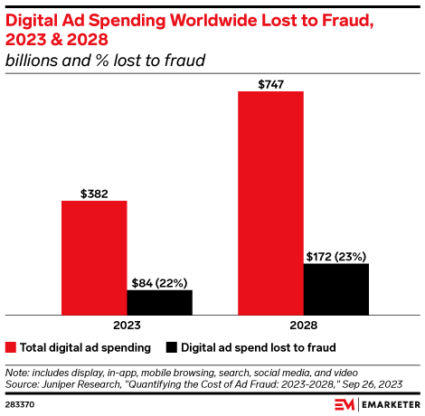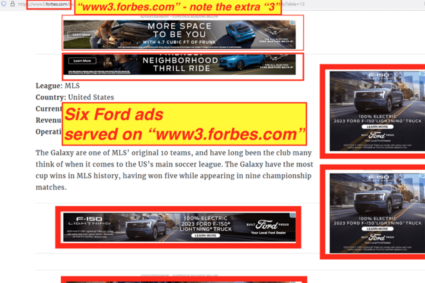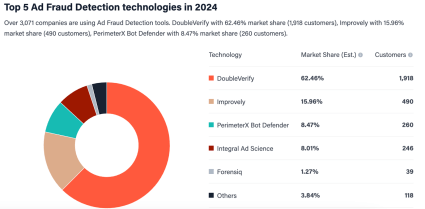Many types of ad fraud have been on the rise in recent years, but one problem in particular has made waves in the industry lately: made for advertising (MFA) websites. In April, Forbes was accused of selling MFA media to brands under the guise of legitimate ad space, and the eyes of the marketing world collectively shifted to the widespread problem of spammy websites eating up ad dollars.
These websites are far from new, but they’ve multiplied precipitously over the years–a recent report from the Association of National Advertisers (ANA) found that MFAs represented 21% of impressions and 15% of ad spend.
With that much money on the line, brands must consider how MFAs might be siphoning off big chunks of their ad budgets, but that’s easier said than done. Since MFAs are hard to identify and exclude from media, they create a new set of challenges for agencies and brands seeking quality media performance.
So how can you make sure your brand isn’t wasting precious ad dollars on spammy, low-quality sites?
Download the details: what is an MFA site?
MFA sites are created to maximize the number of ads users are exposed to on a given page. They’re often interchangeable with ad farms or clickbait sites and are solely focused on generating ad revenue, rather than driving performance for the advertisers. They typically have low engagement and few active users, which shouldn’t be a surprise: the sites tend to feature low-quality content and offer a poor user experience characterized by ad clutter, disruptive popups, and other distracting advertising tactics.
Major advertising gatekeepers like Yahoo, Google, Integral Ad Science, and more have said they plan to make efforts to address the issue of MFAs, but an Adalytics report found that many companies were still not discarding MFA impressions or continued to exchange on these websites. That can add up to a big drain on advertising budgets.

Source: eMarketer
If you’re not sure if you’re looking at an MFA site or just a website with a bad user experience, you’re not alone. The ANA, in partnership with other marketing and advertising trade organizations, outlines five traits of MFA sites that can help you assess a site:
- A high ad-to-content ratio: These sites are cluttered with advertisements, usually featuring at least twice the average number of ads.
- Many auto-refreshing ad placements: Changing ads or continually updating banner ads are constantly distracting users and tactics like multiple autoplay videos and slide shows force visitors to click through pages of ads before accessing content.
- Paid traffic sourcing: These websites often have very little or no organic traffic. They rely on visits from clickbait ads on various platforms and on paid traffic (a major operating cost that leads publishers to take part in more aggressive monetization).
- Generic content: It should be no surprise that these websites aren’t exactly running the highest-quality content, either. MFA websites generally feature non-editorial or templated, low-quality content, and often rely on dated and non-unique pieces.
- Poorly designed, templated websites: MFA websites are also usually badly designed overall.
Digging in: the impact of low-quality websites on your brand
Although we know MFA sites aren’t the best on the web, you might be wondering why it’s such a problem is if your ads are served on them. After all, if your ads are appearing in front of users, why should you care about the exact website they’re on?
One major issue is that the ad overload on these websites leads to wasted impressions for your brand. Since MFA sites often have more ads than content, each space is less valuable and the amount of attention users are paying to each individual ad is inevitably very low.
Overall performance will also suffer when ads are placed on MFA sites, since they prioritize their own ad placement and monetization rather than optimizing for a brand’s performance outcomes or the user experience. Your audience won’t be as interested in clicking through ads on a low-quality, low-attention site and they’ll be less likely to remember your brand in the future.

Source: Adalytics
Beyond the avalanche of ads, bad content usually drives low-quality traffic, which leads to accidental clicks and traffic with higher bounce rates and no action.
There may be an even more important consideration in play: your brand image can take a big hit when users see your ads on spammy sites. According to IAS, 81% of US consumers find it annoying when a brand appears next to low-quality content; 52% feel less favorably toward a brand that does this; and 62% will stop using the brand altogether if its ads appear adjacent to low-quality content.
Problem-solving: how to save your ad dollars from MFA websites
With the recent proliferation of fraudsters, every business should be seeking out tactics that will protect their advertising from different kinds of fraud, MFA sites included.
But that can be easier said than done: not all of these sites are created equal. That makes it hard to catch where these sites are affecting your advertising. Monitoring and evaluating your inventory is a good starting point, but most companies will need to address each site individually to solve the problem.
You also shouldn’t rely on demand-side platforms (DSPs) like Google to grade their own homework; instead of relying on a DSP’s viewability reporting to detect fraud, your team should use a trusted third-party brand safety verification partner like Moat, DoubleVerify, or Jounce to monitor sites for pre-bid and post-bid quality. MFAs are built to perform well against viewability, so you need to ensure that you’re looking at a full suite of brand suitability and engagement metrics to catch problematic websites.

Source: 6Sense
Next, you should implement pre-bid filters that optimize toward media quality and safety, which prevents bidding on ad inventory with fraudulent or suspicious traffic. This can stop problems before they happen; there are even providers that offer MFA-specific filters.
But filters aren’t enough to protect your brand from these issues entirely. Because MFAs appear at an individual site level and can bypass brand safety filters, you may need to block them on a site-by-site basis. Perform regular site list evaluations and block questionable sites to weed out any that have slipped through.
New MFAs appear so frequently and can generate new domains so quickly that some brands may prefer to run on an inclusion list instead, creating a limited list of sites to run ads on. This gives you better control over where your advertisements run and helps you maintain stricter brand safety guidelines but can be a challenge to scale for most businesses.
The long game: media planning and fraud
Now that you know how to spot and prevent them, it’s time to consider how these websites and other types of fraud impact your strategy. Every brand has different priorities and tolerance for risk, so prevention tactics will look different for every business.
For some brands, there might be some benefits to advertising on MFA websites. Performance is usually poor on these sites, but some have stronger returns–if these ads are doing well, what balance does your brand want to strike when it comes to driving outcomes vs. maintaining your brand perception and keeping to quality websites?
In some cases, you may want to keep advertising on MFAs that are efficient for your brand. But you need to keep in mind that efficiency ≠ incrementally. If you are getting a positive, proven incremental impact from certain MFA sites, you might consider keeping them in the media mix. But you should still make sure you’re keeping an eye on where your ads appear to make sure those sites align with your company’s values and performance goals. In general, MFA sites will not be particularly effective.
The primary rule should always be to stay in control of your ad spend and understand where your dollars are going and how any ad placements are helping you achieve your business goals. To protect our clients from ad fraud, Wpromote works with preferred SSPs like Pubmatic that don’t contain any MFA sites in their inventory, then overlay brand safety tracking like in-platform pre-bid filters and solutions that will block bad actors like IAS and Double Verify. We recommend building a customized playbook that fits your specific strategy and goals so your team knows how to respond to any new sites on their radar.
New types of fraud are developing every day: you need to constantly monitor emerging trends in the advertising ecosystem to stay on top of new safety risks and maintain an advertising presence that’s efficient for your business.







Responses